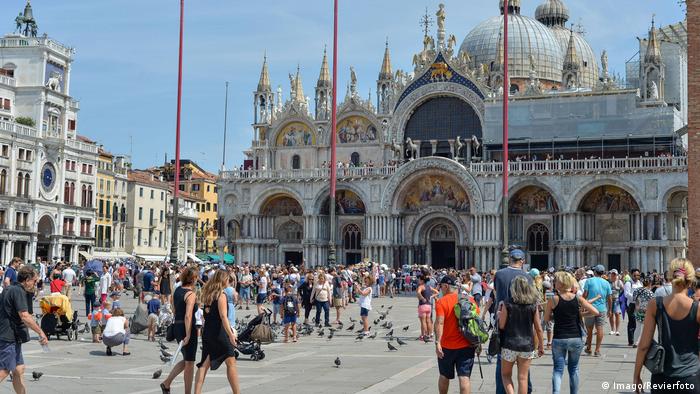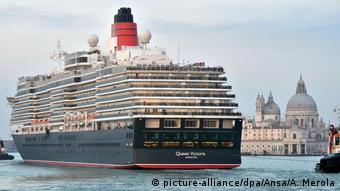TRAVEL
Overtourism: where will it take us?
This article, from DW TRavel illustrates the conundrum for may destinations. At the ITB travel trade show in Berlin “overtourism” is hotly debated. Majorca, Venice and Berlin — they all suffer from the excesses of tourism, even though tourists are an important economic factor. So are there real limits to growth for the tourism sector and for its components? Do the masses help save precious cultures and ecosystems, or are they the prime force for degradation? This article is the fifty on the CACOR site on this issue – with new studies mainly from European sources. See also the posts on this site on Dec 13, Nov 25 , Aug 7 and May 19 which further address the impacts of tourism on destinations and cultures.
At the start of a New Year plans are often made and wishes noted, including the so-called bucket-list, featuring desired holiday destinations. These are places or sights which one should definitely have seen in a lifetime.
At the end of last year, the American travel guide Fodor reversed that list for the second time. They listed the top 10 places not to visit in 2018, including the Galapagos Islands, the Chinese Wall, Amsterdam and Venice. A similar list by CNN in January also included Italy’s Cinque Terre, Barcelona, Bhutan and also Venice.
Avoid Venice? Respect Venice?
“There is no other place that is visited so often by foreigners and is yet so unknown,” author Thomas Watkins already noted back in 1788.
Mass tourism of recent years has taken its toll on the lagoon city. Particular annoyances are the ever growing cruise ships that often unleash thousands of travelers at once on the Piazza San Marco. Overall, some 22 million visitors flock to Venice annually. A process of displacement with consequences: The inner city now only counts some 55,000 inhabitants, compared to 175,000 back in 1951.
Venice does not want to lose the income generated by tourism, so the city is attempting to control the rush of visitors. In future the big sea cruisers are to berth outside of the historic center and travelers are to be guided to lesser known sights. Supported by the International Year of Sustainable Tourism for Development, the city launched in 2017 a campaign under the hashtag #EnjoyRespectVenezia, which appealed to conscientious visitors.
Among the 12 recommendations and rules for the responsible visitor the first one is: Discover the hidden treasures of Venice in the least visited places. This is followed by the advice to explore the islands in the lagoon and to taste local products and enjoy typical Venetian cuisine.
Rules to combat over-exploitation on Majorca
The sight of giant cruise ships at the gates of their city is all too familiar to the inhabitants of Palma, the capital of Majorca. Last summer there were as many as seven ocean giants anchored there on a single day. Last year this popular holiday island also saw protests against the excesses of mass tourism. The residents complain of overpriced flats, pollution, over-crowded beaches and shortages in drinking water. Twelve million visitors in 2017 left their mark – that was a new record and an increase of 10 percent over the preceding year.
The regional government is trying to counteract the rush of tourists with rules and penalties. The tourist tax, introduced in 2016 is to be doubled this year. This summer, cruise ship passengers and hotel guests will have to pay €4 ($5) a day. Those renting out properties without a license will be fined as much as €40,000.
Currently a law is being drawn up which will compel car rental firms from 2020 to increase the number of electric cars by 10 percent every year. Rental cars are seen as a serious environmental problem on Majorca. During the summer season, some 90,000 cars are used. During the winter, the older models are sold to private individuals. This results in Majorca having the greatest vehicle density in Spain, some 85 cars for every 100 inhabitants.
Seeking the better Berlin visitor
Berlin has also experienced the downside of mass tourism. Europe’s party town has repeatedly witnessed conflicts between inhabitants and visitors. Nearly 13 million tourists flocked to the German capital in 2017.
Residents in the popular districts of Kreuzberg, Friedrichshain and Neukölln complain of noise, waste and displacement because of holiday rentals.
The Berlin Senate introduced its tourism concept “2018+” at the beginning of the year. Whereas in the past the aim was to increase the number of tourists, it now is seeking to attract quality tourism. Visitors to congresses, gourmets and those interested in culture are to be attracted rather than party tourists. Their Berlin experience along with the quality of life of the residents is to be improved.
The measures to counteract the excesses of mass tourism include better infrastructure for cyclists and water tourists. Furthermore Berlin visitors are to be informed that the surrounding areas of the capital, from Lake Wannsee to Marzahn offer attractive excursion destinations.
Compared to Majorca and Venice the effects of overtourism in Berlin are manageable. Sometimes problems unexpectedly solve themselves. Air Berlin’s bankruptcy for instance meant that the number of tourists didn’t increase as much as critics feared and tourist businesses were hoping for.
DW RECOMMENDS: These articles from DW further explore this issue. See http://www.dw.com/en/overtourism-where-will-it-take-us/a-42863355
Tourism is booming – and so are its side effects
Worldwide tourism will be celebrating a record year in 2017. The UNWTO had wanted to counter tourism’s negative consequences on local residents and environments with a Year of Sustainability. A preliminary stock-taking. (27.12.2017)
How to avoid the tourist masses in Venice
“Tourists destroy what they are looking for by finding it,” wrote German writer Hans-Magnus Enzensberger — and that applies to Venice today. Still, DW reporter Juan Martinez has found ways to avoid the crowds. (21.02.2018)
Venice: Growing protests against tourists
Berlin, Mallorca, the Italian Riviera – all these popular vacation destinations are also home to local protest movements against the masses of tourists. Now a similar dispute has come to a head in Venice as well. (19.08.2016)
Mallorca may limit number of tourists
Regional politicians say the Balearic Islands have reached total capacity in the summer months. Now they plan to introduce a tourist tax and reduce the number of package tour visitors. (15.07.2015)
‘Overtourism’ swamps Amsterdam
The Dutch capital is now pushing back in an attempt to keep the city attractive to visitors and residents alike. But some say it’s not going far enough. (18.12.2017)






Leave a Reply